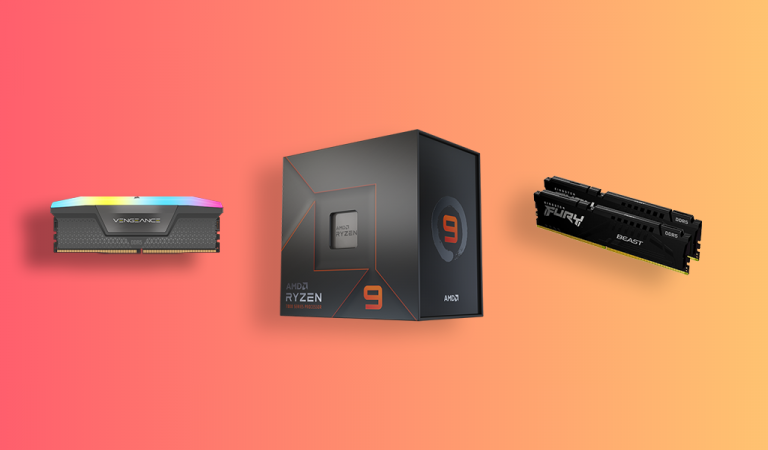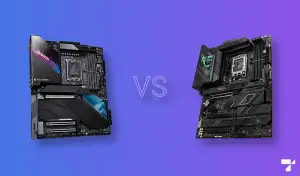AMD Ryzen is famously known for optimizations related to RAM tunings. Because of this, the shift to DDR5 changes the game quite a bit for the platform and gives the AM5 socket even more options for enthusiast-level customization. This is especially true if you plan on building a PC with the Ryzen 9 7900X. High frequency and low latency are still basic priorities. But when choosing the best RAM for Ryzen 9 7900X, the direction is now tilted slightly to different directions depending on your needs and budget.
That being said, RAM is still RAM. Your priority is to keep providing the optimal performance headroom for DDR5’s memory controller. For example, better heat spreaders become more necessary. The same goes for component monitoring and power delivery features.
CAS latency is not much of a concern for DDR5. Most consumer-level memory module kits out there already have the baseline XMP/EXPO profiles to make the most out of the DDR5 without (component) bottlenecking issues.
The Ryzen 9 7900X, much like its other family members does have slightly more specific requirements for daily-driver-level memory frequency. Though, because its Infinity Fabric is recommended to be set at auto, you only have to worry about getting to at least 5,200Mhz for basic optimization. The sweet spot for the 7900X is 6,000Mhz, where anything beyond might actually provide diminishing returns in terms of price to performance. Nevertheless, the RAM recommended below all perform well with both the Ryzen 9 7900X as well as the non-X Ryzen 9 7900.
Best RAM for Ryzen 9 7900X
1. G.Skill Trident Z5
Verdict
The G.Skill Trident Z5 exudes a stylistic finish, with memory-intensive applications making good use of default overclocking profiles. The modules, however, come at a significantly more premium cost than the competition.
Specifications
Memory Type: DDR5 | Capacity: 32GB (2x16GB) | Speed: 6,400MHz | CAS Latency: 32 | Timings: 32-39-39-102 | Voltage: 1.40V | Height: 45mm/1.77″ | Warranty: LifetimeBenefits
- Noticeable time reduction in memory-sensitive software
- Good out-of-the-box usability
- LED lighting gives a nice glow
Drawbacks
- Not for pure gamers (too expensive)
- Tall heat spreader height
Buying Options
If you’re only objective is to buy the best DDR5 memory kit that would reach the final destination quickly for your Ryzen 7000 platform, and the cost isn’t an issue, then the G.Skill Trident Z5 is probably your optimal choice. With a good default 6,000Mhz clock speed and very nice CL32 timings (for DDR5), your investment will immediately provide good, tangible returns in productivity apps that need an extra boost in efficiency.
Be wary, though, that if only for the purpose of gaming this RAM may be too excessive. For the very few memory-sensitive titles, the gains might just be barely noticeable. Probably not something too appreciable on a larger scale, especially when going beyond 1080p gaming. Maybe for competitive gaming, sure. Else you should aim for a cheaper DDR5 option that is more cost-effective for gaming. However, if you plan to you this RAM for more than just gaming, such as computationally demanding workloads it should perform fantastically and be of value.
Tall heights aside, it still has the soul of what makes G.Skill Trident Z modules so attractive. Practical double-color combinations start from black, plus all the curves and straight lines that make your PC seem like a living machine. Great for any motherboard with a gunmetal finish.
RGB LED lighting is top-notch as well. It’s not eye-searing-level bright, but just enough of an ambiance to once again, bring about that mechanized feel to your PC build. It syncs pretty easily as well.
All in all, we still consider it the best RAM for the Ryzen 9 7900X for the same reasons that it is a very good RAM kit for the Ryzen 9 7950X: great performance out-of-the-box, with balanced aesthetics to boot.
2. Kingston Technology Fury Beast
Verdict
This 64GB Kingston Technology Fury Beast has ample capacity and despite its meager looks is still a very fast and reliable pair of DDR5 memory. It performs well with the Ryzen 9 7900X and you can also opt for the RGB version of this RAM.
Specifications
Memory Type: DDR5 | Capacity: 32GB (2x16GB) | Speed: 6,000MHz | CAS Latency: 40 | Timings: 40-40-40-80 | Voltage: 1.40V | Height: 35mm/1.37″ | Warranty: LifetimeBenefits
- Usable out-of-the-box (no tweaks needed)
- Low-profile heat spreader
- Relatively cheap-ish
Drawbacks
- Weird CL timing tweaking
- Not much flair in heat spreader design
Buying Options
Kingston’s Fury Beast RAM kits have been basically the standard modules for the everyman. 6,000Mhz brings us to the tail end of the Infinity Fabric sweet spot. But don’t expect miracles. It won’t suddenly make productivity apps super fast, but the half-tier boost is potentially there, should users ever need it.
One somewhat strange experience we had testing these modules, though, is that a few of the kits don’t seem to be very lenient with CL timings. You will usually be stuck with the basic OC profiles or bringing timings down just to sacrifice a bit of its OC setting. In any case, this should not be a problem for the Ryzen 9 7900X in particular. Just a bit of disclaimer info for those interested in playing around with its settings.
Aesthetically speaking, they’re standard black memory sticks. Very basic heat spreader, one that doesn’t really lend to any specific theme, but is also generic enough that you can slot it anywhere. RGB is non-existent, of course, and it is up to the user whether it should be treated as an advantage or not.
The Fury Beast DDR5 is best for smaller form factor systems that require tighter clearances. Even the heftiest of downdraft coolers shouldn’t have any problems with this.
So, while there is a bit of a conflict to its tweaking factor, the Fury Beast memory kit is more than enough to let your Ryzen 9 7900X plow through daily-driving applications without a hitch. Certainly not anything that would hinder the maximum performance of any AM5 system using it.
3. Corsair Dominator Platinum
Verdict
Corsair’s Dominator Platinum DRR5 memory continues to represent the universal ease of use for the Dominator series. Starting from its out-of-the-box performance, down to the somewhat good-ish headroom it provides for more savvy users.
Specifications
Memory Type: DDR5 | Capacity: 32GB (2x16GB) | Speed: 5,200MHz | CAS Latency: 38 | Timings: 38-38-38-84 | Voltage: 1.25V | Height: 56mm/2.2″ | Warranty: LifetimeBenefits
- High-quality looks
- Sexy and stylish
- Great out-of-the-box performance
Drawbacks
- Not much OC freedom (for its class)
- 56mm heat spreader height
Buying Options
Corsair Dominator Platinum is aimed at dedicated AM5 platform users that just need an aesthetically pleasing, yet trusty DDR5 module kit that covers all the bases and provides no additional trouble. Lower clocks it may have, but it is still within the spec of what Ryzen 7000 needs by default. Besides, it is to be used for a Ryzen 9 7900X, so it can certainly leave a room or two for lower clocks in exchange for a much higher CPU cache.
In particular, the 5,200Mhz fits right into the baseline 1733Mhz Auto Infinity Fabric target. So optimization-wise that should be enough for a start. Unfortunately, this 5,400Mhz is as far as you can go without additional CL timing tweaks. While reaching 6,000Mhz would have been appreciable, performance-wise you’re not falling too far behind unless you have a professional use case for it.
The signature Dominator Platinum design and finish is still one of its best assets. Its flat and sleek heat spreader makes it look comparatively more attractive than the competition. Height clearance might be an issue, but on a high-end system, you would either have a huge space for bigger components, or the CPU simply uses an AIO cooler.
To add to its flair, its RGB provides this very vibrant color that doesn’t hurt the eye. While the default pattern that combines with its metallic casing is already attractive enough, the iCue software gives you even more options to make it even more eye-catching.
4. Corsair Vengeance
Verdict
Corsair Vengeance retains reliability and stability beyond the tier of its improved entry-level looks. Treat it as your AM5 platform’s basic daily driver kit for day-to-day use.
Specifications
Memory Type: DDR5 | Capacity: 32GB (2x16GB) | Speed: 5,600MHz | CAS Latency: 36 | Timings: 36-36-36-76 | Voltage: 1.25V | Height: 35mm/1.38″ | Warranty: LifetimeBenefits
- Nice OC headroom (for its product category)
- Low-profile heat spreader
- All-around stable performance
Drawbacks
- Thin heat spreader
Buying Options
Corsair Vengeance is a more value-focused memory kit that has an updated design. This 5,600Mhz CL36 version DDR5 RAM kit offers very impressive OC settings and timings, while also being fantastic out of the box. It provides just a bit more OC headroom, opening up slightly more allowance to tweak timings for those who enjoy optimizing memory kits further.
While the heat spreader design could be improved, it is still more than sufficient. The overall updated visual design with the patterns actually do look nice and is an upgrade over the previous DDR4 Corsair Vengeance. Thickness is kind of concerning though, as they’re really thin to look at. Thankfully this seems to be a non-issue as this RAM kit does perform quite admirably.
To conclude, the Corsair Vengeance is excellent for AM5 systems and performs well with the Ryzen 9 7900X. No tweaks are necessary, and no unforeseen stability issues should occur. At least, you can prevent those that might put a considerable dent in the otherwise great performance of the 12-core Zen 4 CPU.
5. XPG Lancer
Verdict
The XPG Lancer memory modules are idle those who want great DDR5 performance with the looks to match while having a premium unibody heat spreader design comparable to top competitors.
Specifications
Memory Type: DDR5 | Capacity: 32GB (2x16GB) | Speed: 6,000MHz | CAS Latency: 40 | Timings: 40-40-40-80 | Voltage: 1.25V | Height: 43mm/1.69″ | Warranty: LifetimeBenefits
- Nice CL timing headroom
- Great stability (within a reasonable degree)
- Unified RGB lightning
Drawbacks
- PMIC doesn’t seem to have a thermal pad on it
Buying Options
Feature-wise, the XPG Lancer should be an enthusiast-level product, but its price reflects that of a mainstream item quite more, at least when compared to other DDR5 modules. As expected, its 6,000Mhz and CL40 timings are put to very efficient use. The combined stability and reliability allow it to compete head-to-head with the rest of the more pricey items on this list. In fact, so long as the settings are not so ridiculous, the system won’t ever crash on it.
Though, we do really appreciate simply using it for its default XMP/EXPO profiles, as this is where most synthetic benchmarks tend to agree with what it can offer. Besides, that’s really all you can do if you are a gamer planning to buy these modules.
Heat spreaders are long, sleek, and square. Quite tall, but not alarmingly tall. Its black slate and brushed aluminum finished look and feel quite premium, and its size surely helps in controlling temperature as well.
Oddly though, upon inspecting inside, the top section where the PMIC should be, does not have any connecting thermal pad for the heat spreader. Doesn’t seem to affect performance though, since its default OC settings still work perfectly regardless.
Unified RGB lighting works as expected. While not too impressive, it is still somewhat remarkable for the ease of use and intuitiveness that the related software provides for its use.
To recap, the XPG Lancer is representative of what we should expect with DDR5. True, it is intended to be a premium product. But its usability, features, and aesthetics properly show the trifecta of value as a consumer product.
What To Look for When Buying Ram for the Ryzen 9 7900X
Capacity
16GB (x2 8GB) remains the sweet spot standard for DDR5, but with such a high-end processor 32GB starts to sound more sensible. At least with 32GB, the professional productive capacity of your system is increased even further. Not only can you leave apps open simultaneously to work on at a later time during the day. But, specific apps, such as encoders and video editors, might also need that much RAM in order to maintain their snappy, responsive use. Gamers shouldn’t really use the Ryzen 9 7900X, but for such purposes, specific games like Kerbal Space Program would appreciate the additional asset headroom. Consider 64GB if you can actually push the system to its maximum productive limits.
Frequency
Go for 5,200Mhz at minimum, then tweak as much as you can upward to 6,000Mhz. The Infinity Fabric value of Ryzen 7000 is at 1733Mhz, which equates 5200Mhz DDR5. Users should take note that the Infinity Fabric for Ryzen 7000 no longer follows the direct ratio between the Fabric clock, memory clock, and memory controller clock. Instead, the Fabric clock should always be in Auto. 6,000Mhz is considered the maximum sweet spot target, but you don’t really have to worry about it too much for the Ryzen 9 7900X. Just find a good, stable profile between the minimum and maximum values.
Latency
Latency isn’t a big concern for DDR5 and Zen 4. It is recommended to get it as low as possible. But if you can’t don’t worry too much about it. The Ryzen 9 7900X still has its 64MB of L3 cache. Using a good DDR5 kit with a reliably higher speed than 4800Mhz, delays between command line completion times become much less of an issue.
Dual-Rank versus Single-Rank
Dual-rank memory is faster than single-rank memory. Small difference, but still quite measurable. Simply put, using the same frequency, dual-rank processes more data on both sides of the stick. Unlike single-rank sticks that do it only on one side. This puts a strain on overclocking though, making the single-rank sticks better in OC by default. There is also the issue of syncing RAM sticks on dual-rank, as it may not be possible to use the default OC settings when four of them are installed at the same time. If the tuned-down value would go below 5,200Mhz, it is recommended that you just keep using two sticks only.
Dual-Channel versus Single-Channel
Dual-channel is better than single-channel. Putting RAM in dual-channel doubles the available bandwidth for the memory controller. As such, it is imperative to use at least two memory modules at a minimum and install them into the correct configuration that uses them in dual-channel. On a four-DIMM slot motherboard, you either match the colors of the slots or plug them into alternate positions. If you’re still not sure, refer to the instruction manual of your motherboard to confirm.
Pricing
For the price, the target CPU (in this case the 7900X) gets the heavier investment first before RAM. Pricier memory modules can be justifiable if you need more capacity for the Ryzen 9 7900X. However, you should aim to pay for less than half of the CPU’s price for its RAM.
Final Thoughts
The Ryzen 9 7900X is a small step down with its 12-core/24-thread configuration, but it still shares the same 64MB of L3 cache as a 7950X. Therefore, you can expect DDR5 modules paired with this CPU to more or less behave in the same way: good leniency for all types of frequencies and timings. So long as you can keep the entire system cooled, and profiles are properly set, then any good quality compatible RAM should work with the intended optimized performance that it should bring. The same also applies to the non-X Ryzen 9 7900.
Again, those who have the investment to do so are still encouraged to jump to higher tiers to achieve better results. But, never expect a huge jump. Because after all, the Infinity Fabric is adjusting automatically this time to whatever timings you feed it into.



